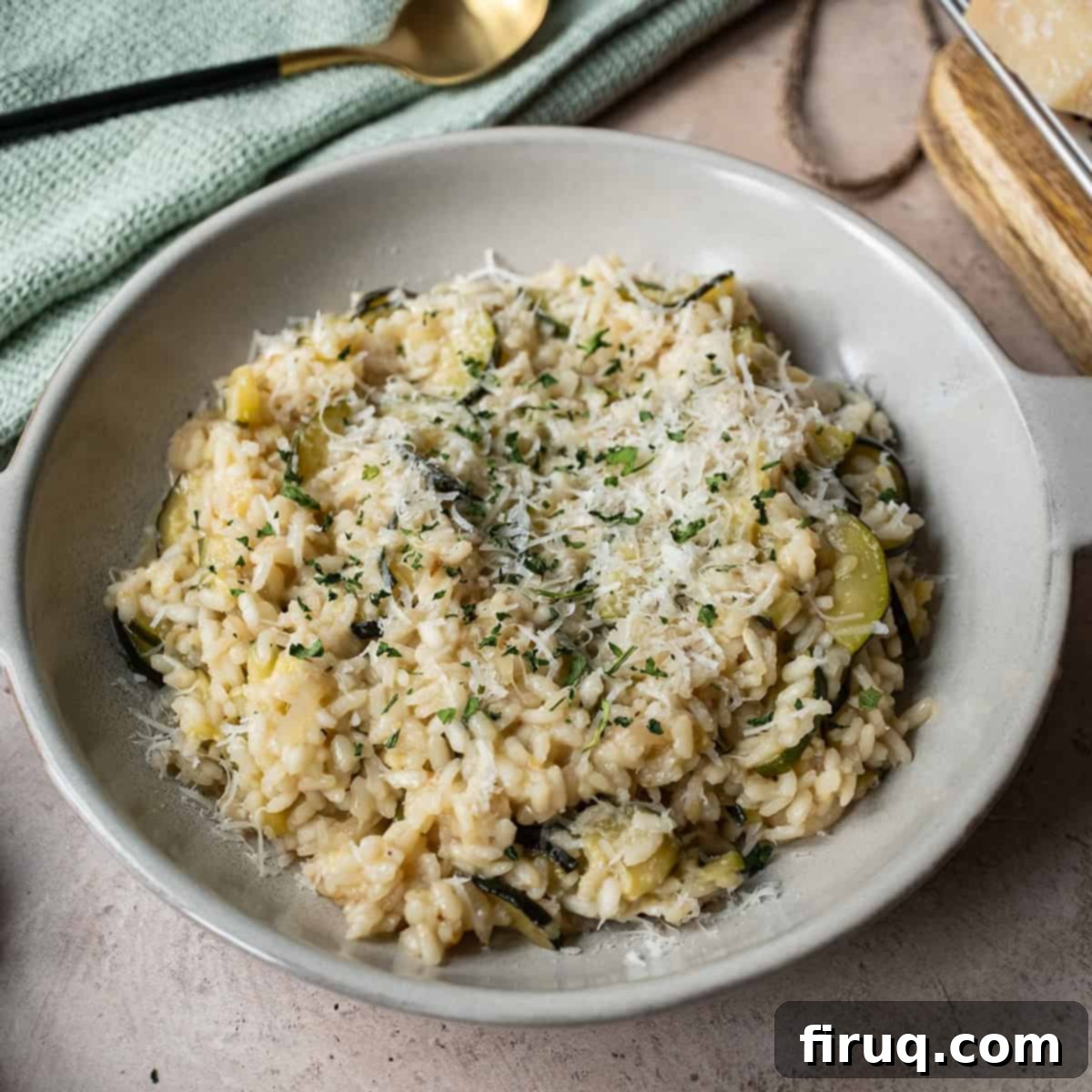Mastering Creamy Zucchini Risotto: Your Ultimate Guide to a Perfect Summer Dish
As the days lengthen and the sun warms our gardens, zucchini emerges as the undisputed star of summer produce. Its versatility and delicate flavor make it an ideal candidate for a variety of dishes, but for me, nothing quite captures its essence like a perfectly crafted zucchini risotto. This dish isn’t just a meal; it’s an experience – a chance to impress family and friends with an incredibly delicious, yet surprisingly approachable, elevated dining experience. Once you master the fundamental technique of risotto, incorporating a fresh summer vegetable like zucchini becomes an absolute breeze, transforming simple ingredients into a rich, creamy, and satisfying masterpiece.
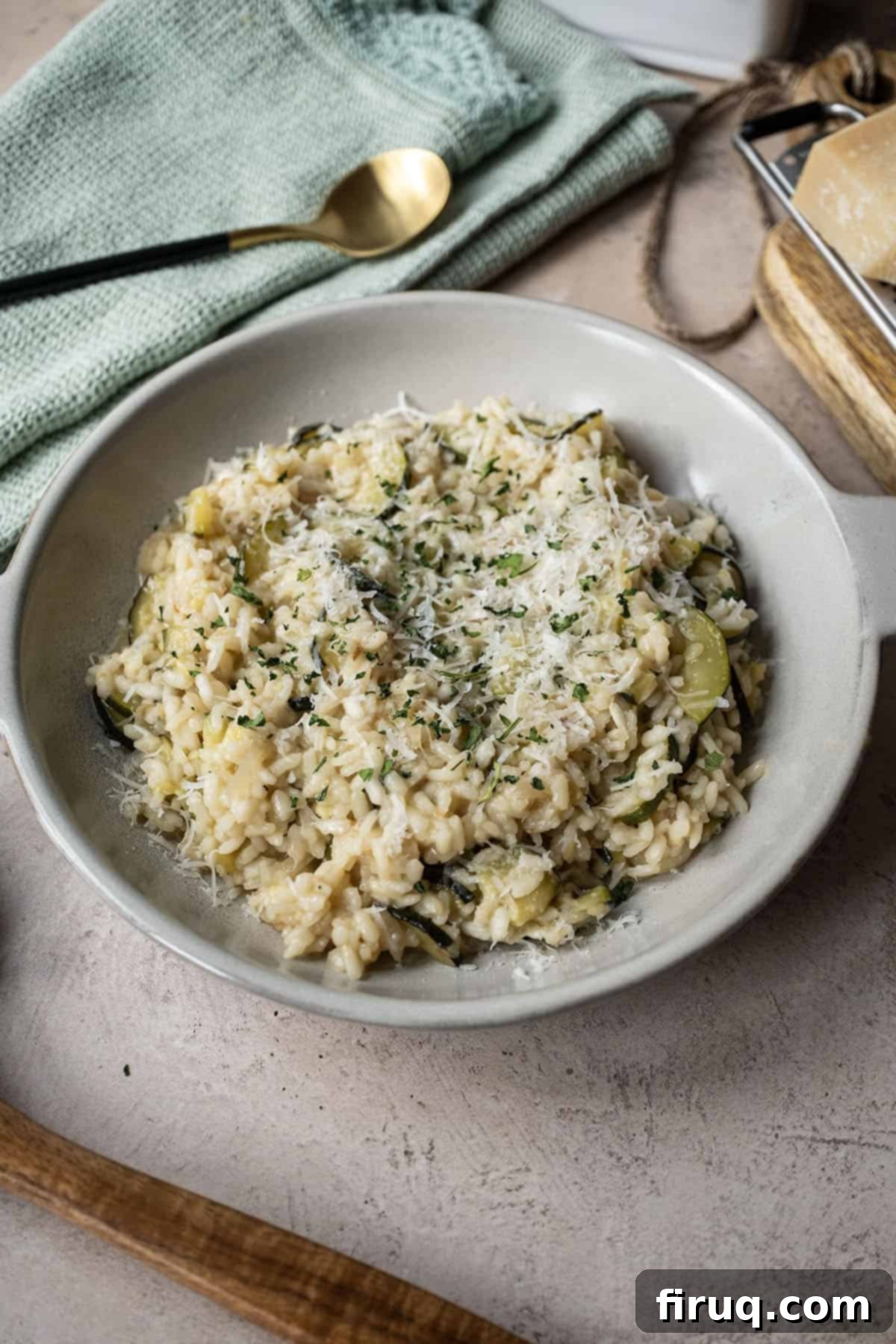
This creamy zucchini risotto stands as a testament to elegant simplicity. It’s perfect as a sophisticated side dish or a light, yet fulfilling, main course. If you’re planning a dinner party or simply seeking to elevate a weeknight meal, consider serving this exquisite risotto alongside complementary main dishes. It pairs beautifully with delicate proteins such as Pan-Seared Vermillion Snapper or a hearty Classic Pork Chop Milanese. For those who appreciate a variety of Italian starches and flavors, explore other delicious options like Pasta Alla Gricia or Bucatini Amatriciana. Whichever way you choose to serve it, this zucchini risotto is sure to be a crowd-pleaser.
The Art of Learning Risotto: Impress with Ease
There’s a certain mystique surrounding risotto. Many home cooks shy away from it, believing it to be a complex, labor-intensive dish reserved for professional chefs or upscale restaurants. However, this perception couldn’t be further from the truth! Risotto is not inherently difficult; it simply requires a bit of patience and a gentle, consistent technique. This is precisely why I revel in making risotto when I want to dazzle my dinner guests. The sheer act of serving a homemade, perfectly creamy risotto is often enough to elicit gasps of delight and genuine compliments. Whether it’s the rich earthiness of The Creamiest Mushroom Truffle Risotto or the vibrant freshness of a Creamy Cherry Tomato Risotto, a well-executed risotto always leaves a lasting impression. My zucchini risotto, in particular, consistently earns rave reviews.
Zucchini truly shines in a risotto context. It’s an exceptionally forgiving and cooperative vegetable to work with, largely due to its high water content. As it cooks, zucchini gently releases its liquid, which is then readily absorbed by the starchy Arborio rice, contributing to the dish’s overall creaminess and depth of flavor without overpowering it. This natural interaction simplifies the risotto-making process, making zucchini an effortless and delightful addition. Given how abundantly zucchini grows in summer gardens, it’s incredibly easy to source, often leading to a surplus. Instead of letting those extra zucchinis languish in the fridge, transform them into a culinary delight! Zucchini is a versatile ingredient, perfect for dishes like Italian Summer Pasta with Zucchini or crispy Air Fryer Zucchini Fritters, but its harmonious blend with Arborio rice in this risotto recipe makes it an exceptional choice for a delicious and healthy weeknight side dish or a light lunch.
No more sad, forgotten vegetables at the back of the fridge! Embrace the bounty of summer and let your zucchini contribute to this flavorful, comforting risotto. It’s a fantastic way to utilize fresh produce, minimize food waste, and create something truly special for your table. Plus, its light, fresh flavor profile makes it a perfect complement to heavier main courses or a satisfying vegetarian option on its own.
Ingredient Notes and Substitutions for Zucchini Risotto
Crafting the perfect zucchini risotto begins with understanding your ingredients. Each component plays a crucial role in achieving that sought-after creamy texture and balanced flavor. Here’s a closer look at the key ingredients and potential substitutions:
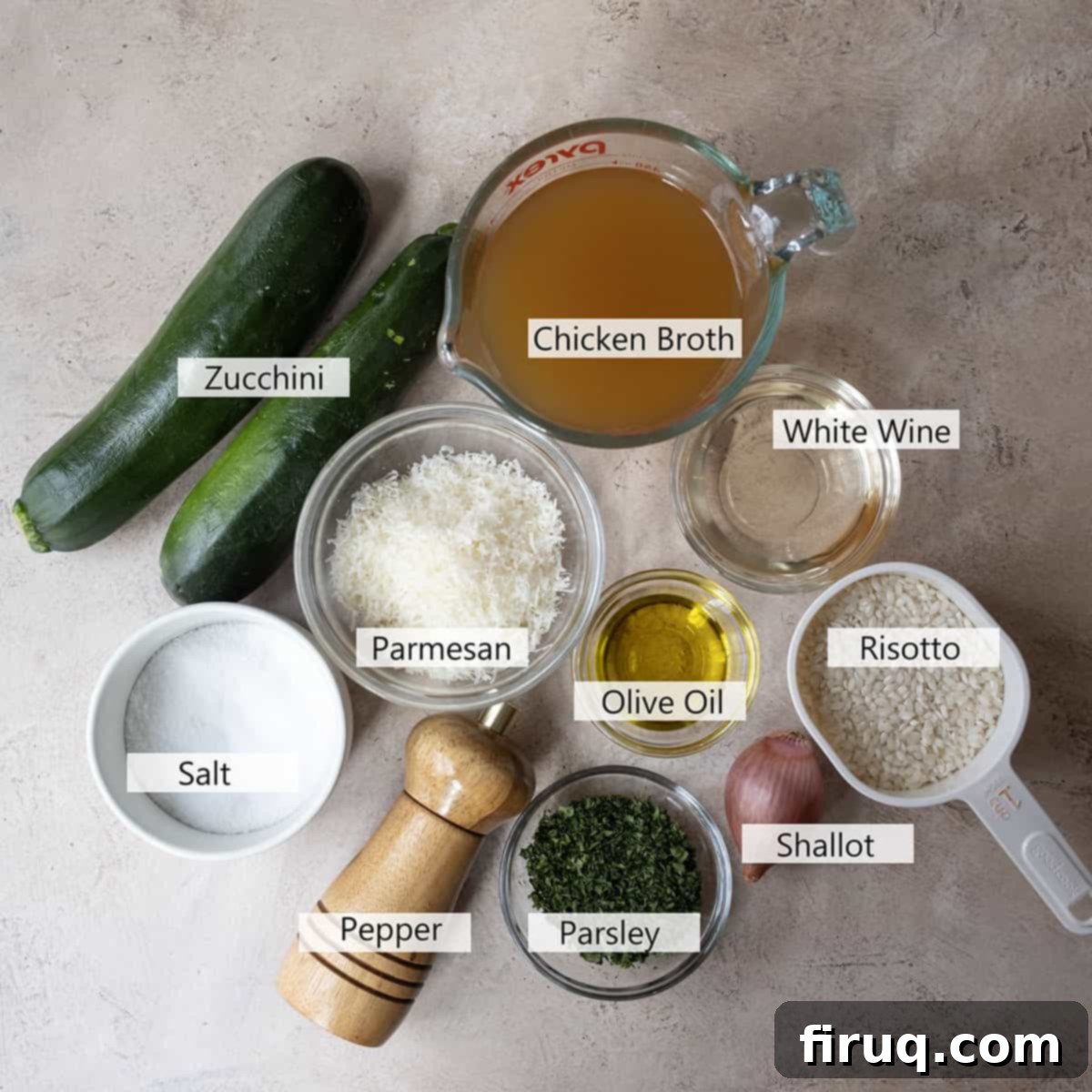
- Shallots: These delicate members of the onion family are a classic choice for risotto. Their milder, sweeter, and more nuanced flavor, compared to standard onions, ensures that they enhance the overall taste of the dish without overpowering the subtle notes of zucchini and Parmesan. If you’re in a pinch, you can use a very small amount of finely minced yellow onion, but shallots truly offer the best flavor balance.
- Zucchini: The star of our show! When preparing zucchini, slicing it into thin, uniform pieces (as shown in the recipe images) allows it to cook evenly and gently release its moisture. Alternatively, grating the zucchini can lead to an even creamier, more integrated texture, though you might lose some of its distinct presence. For substitutions, consider other quick-cooking, mild-flavored vegetables like thinly chopped broccoli florets, yellow squash, peas (added near the end), or asparagus tips.
- Chicken Broth: The foundation of flavor for your risotto. Using high-quality chicken broth will significantly impact the final taste. To make this recipe vegetarian, a good quality vegetable broth is an excellent and easy substitution. Always make sure your broth is warm or hot before adding it to the rice; this crucial step ensures the risotto cooks continuously without temperature drops, which can lead to uneven cooking and a gluey texture.
- White Wine: I highly recommend using a dry white wine like a Sauvignon Blanc, Pinot Grigio, or even a dry Vermouth. The wine serves multiple purposes: it deglazes the pan, adds a crucial layer of acidity that brightens the rich, creamy dish, and its alcohol evaporates, leaving behind a complex depth of flavor. In my opinion, it’s not an optional ingredient for achieving the authentic risotto experience, but if you absolutely must omit it, increase the chicken broth slightly and add a splash of white wine vinegar or lemon juice at the end for acidity.
- Arborio Rice: This medium-grain Italian rice is the most commonly used variety for risotto, widely available in the United States. Its high starch content, particularly amylopectin, is what gives risotto its characteristic creamy texture as it cooks and releases starch into the liquid. Other excellent choices include Carnaroli, often considered a premium risotto rice, which yields an even creamier result and is less prone to overcooking, and Vialone Nano, a shorter-grain rice known for absorbing liquid well and creating a slightly nuttier flavor, though it can be harder to find outside of specialty Italian markets.
- Parmigiano-Reggiano: Freshly grated Parmigiano-Reggiano is essential for that salty, umami-rich finish and adds to the creamy consistency. Avoid pre-grated cheeses, as they often contain anti-caking agents that can hinder the smooth melting process.
*Please see the Recipe Card below for more detailed information about the ingredients and their exact measurements.
How to Make Zucchini Risotto: A Step-by-Step Guide
Creating a luscious zucchini risotto is a journey of patience and precise technique. Follow these steps carefully to achieve that perfect creamy consistency and vibrant flavor:
First, prepare your zucchini. Slice each zucchini into quarters lengthwise, then thinly slice those quarters into uniform ⅛-inch pieces. This ensures even cooking and a pleasant texture in the final dish. If you prefer a more integrated zucchini flavor and texture, you can also grate the zucchini. Simultaneously, warm your chicken broth and water in a small pot over medium-low heat. Keeping the broth hot is a crucial step that significantly speeds up the cooking process and prevents the risotto from losing heat each time you add liquid, which can result in an unevenly cooked or gummy rice.
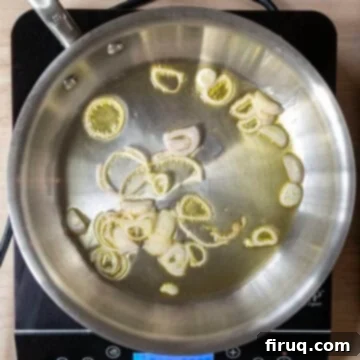
Step 1: Sauté the Shallots. In a large, heavy-bottomed saucepan or Dutch oven, heat the olive oil over medium-low heat. Add the sliced shallots and sauté gently for 2 minutes, stirring occasionally until they become translucent and fragrant, but not browned. This slow cooking extracts their sweetness without bitterness.
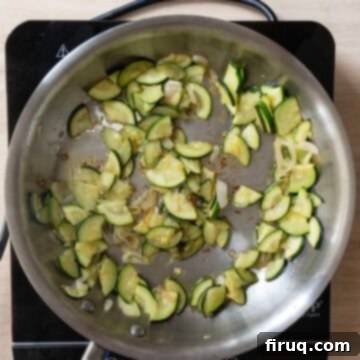
Step 2: Add the Zucchini. Stir in the prepared zucchini slices. Continue to sauté for 6-8 minutes, stirring often and gently. The goal is for the zucchini to soften and become lightly golden, releasing its natural moisture without completely losing its shape or turning mushy. Season with half of the salt and pepper at this stage to build flavor from the beginning.
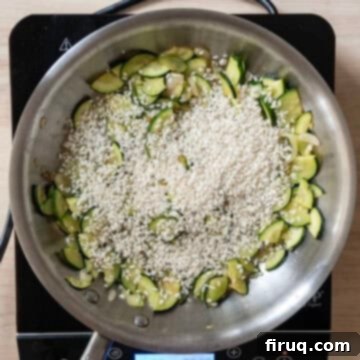
Step 3: Toast the Rice (Tostatura). Once the zucchini is tender and lightly golden, add the Arborio rice to the saucepan. Stir continuously to ensure the rice is fully coated with the olive oil and aromatics. Allow the rice to toast on the pan for about 3 minutes. You’ll notice the edges of the grains becoming translucent, with a tiny opaque white dot still visible in the center. This “tostatura” step prevents the rice from getting mushy and helps it absorb liquid more evenly, developing a nutty flavor.
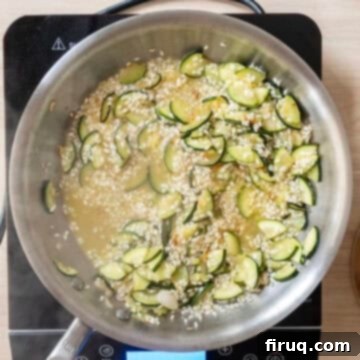
Step 4: Deglaze with Wine. Pour in the white wine and increase the heat slightly to bring it to a simmer. Stir continuously, scraping any delicious browned bits from the bottom of the pan. Continue to cook until the wine is almost completely absorbed and the strong alcohol aroma has cooked off. This process, known as deglazing, adds essential depth and acidity.
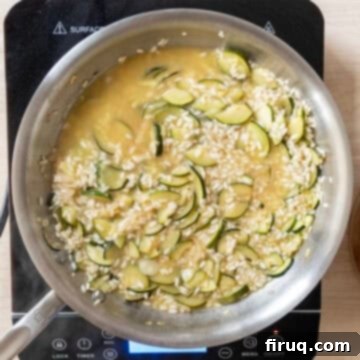
Step 5: Gradually Add Broth. Begin adding the warm chicken broth, one ladleful at a time, to the rice. Stir frequently and patiently. Wait for each addition of broth to be almost entirely absorbed by the rice before adding the next ladleful. This gradual process encourages the rice grains to gently release their starches, creating the signature creamy texture. Remember to stir often; this prevents the rice from sticking to the bottom of the pan and ensures even cooking.
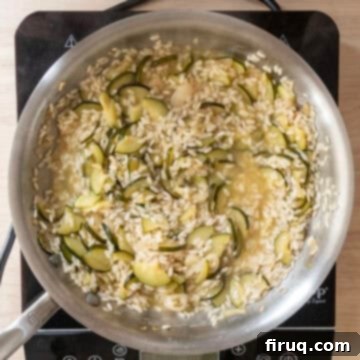
Step 6: Cook to Al Dente. Continue this broth-adding and stirring process for approximately 18-20 minutes. By now, roughly three-quarters of your liquid should be absorbed. It’s time to taste the rice. It should be al dente – soft on the outside but still with a slight, pleasant chew or “snap” in the center, not crunchy or hard. If it’s still too firm, add another ladleful of liquid and continue cooking and stirring until the desired texture is reached.
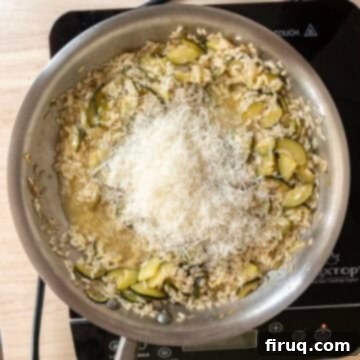
Step 7: Achieve Creamy Consistency (Mantecatura). When the rice reaches al dente, there should still be some liquid remaining in the pan, giving the risotto a loose, creamy consistency—much like a perfectly runny over-easy egg. If it appears too thick, add a little more hot chicken broth until it reaches this “all’onda” (wavy) texture. Remove the pan from the heat. Stir in the freshly grated Parmigiano-Reggiano, the remaining salt and pepper, and fresh parsley. This final step is crucial for flavor and ultimate creaminess.
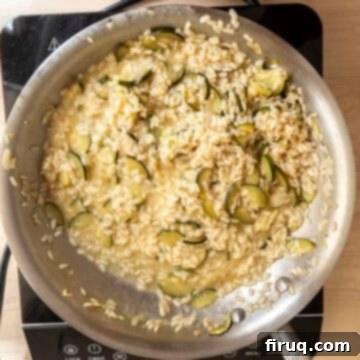
Step 8: Serve Immediately. Toss well or vigorously stir to fully incorporate the Parmigiano-Reggiano. The risotto should flow gently like a wave when you tilt the pan – this confirms the perfect texture. To maintain its exquisite consistency and warmth, it’s best to serve zucchini risotto immediately on a warm plate. Enjoy the fruits of your culinary labor!
Remember, risotto is a dish that waits for no one! It’s always best to serve zucchini risotto immediately after it’s finished cooking, as the rice starches continue to set and the risotto thickens by the minute. Similar to dishes like Lemon Spinach Orzo, risotto generally doesn’t reheat well, losing its delicate creamy texture. However, when fresh, its flavors are vibrant and utterly irresistible. This light and flavorful summer dish, much like Pasta Primavera with Broccoli and Asparagus, makes an excellent pairing for a variety of main courses, from a succulent Italian Cast Iron Pork Tenderloin to a simple grilled chicken breast. Garnish with a sprinkle of fresh parsley and an extra grating of Parmigiano for an added touch of elegance.
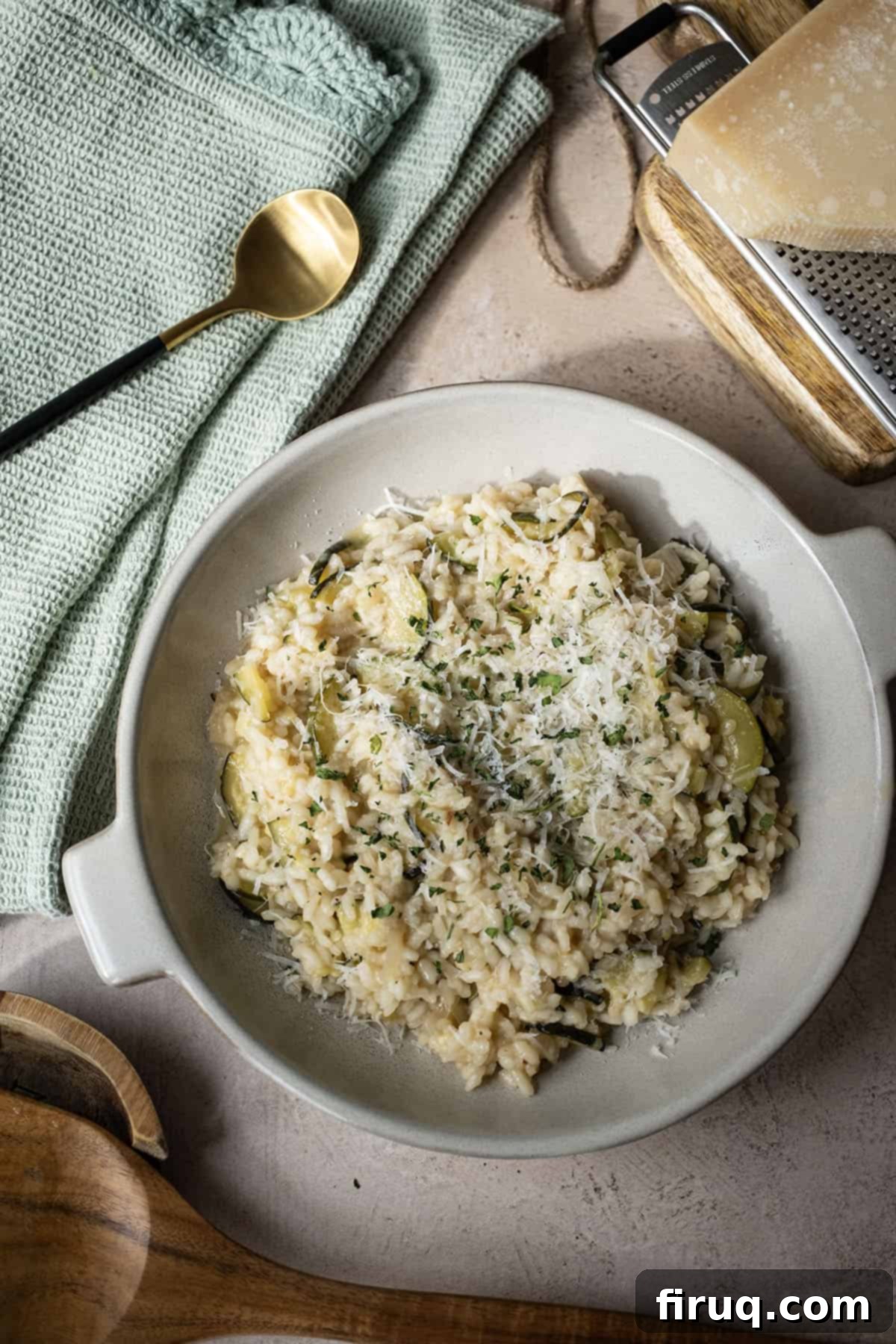
Pro-Tips for Perfect Zucchini Risotto Every Time
Achieving risotto perfection requires attention to a few key details. These professional tips will help you navigate the process with confidence and yield a consistently delicious result:
- Handle Zucchini Gently: The zucchini in this dish is quite delicate. If you wish to maintain some of its lovely shape and texture, stir gently, especially during the sautéing and initial broth additions. Over-vigorous stirring can break down the zucchini too much, turning it into a watery purée rather than distinct pieces within the creamy rice.
- Look for the “White Dot” when Toasting Rice: The “tostatura” (toasting) of the Arborio rice is a critical flavor-building step. When the rice is adequately toasted, you’ll observe a small white dot or opaque center in each individual grain, while the edges become translucent. This visual cue indicates that the rice has formed a protective barrier, which allows it to absorb liquid evenly without becoming overly sticky, and is the perfect moment to add the white wine.
- Master the “All’onda” Consistency: The hallmark of a perfectly finished risotto is its loose and creamy texture, often described as “all’onda” (like a wave). When you remove the pan from the heat, the risotto should still have some liquid remaining and flow like a gentle wave if you shake or tilt the pan. It should not be a solid, sticky mass. If it feels too stiff, add a final splash of hot broth or even a little warm water to achieve this ideal consistency.
- Serve on a Warm Plate: This seemingly small detail makes a significant difference. Serving risotto on a warm plate helps to maintain its temperature and, crucially, its creamy “all’onda” texture for longer. A cold plate will rapidly cool the risotto, causing the starches to seize up and the dish to quickly become thick and less enjoyable.
- Don’t Be Afraid to Taste and Adjust: Risotto is a dish that benefits from constant tasting. Taste the rice throughout the cooking process to gauge its doneness and adjust seasoning as you go. Before the final “mantecatura” (adding cheese and butter), taste the risotto one last time and add more salt and pepper if needed. The goal is a harmonious balance of flavors.
Recipe FAQs: Your Zucchini Risotto Questions Answered
Got questions about making the perfect zucchini risotto? We’ve got you covered with answers to some of the most common queries:
For authentic risotto, you should use short to medium-grain rice varieties specifically cultivated for their high starch content, primarily amylopectin. The most common and widely available option in the United States is Arborio rice. It’s excellent for creating a creamy texture. Carnaroli is often considered a premium choice, yielding an even creamier, more robust risotto that is also more forgiving if slightly overcooked. Another fantastic, though sometimes harder to source, option is Vialone Nano, which produces a slightly nuttier flavor and a wonderful velvety texture. Avoid long-grain rice like Basmati or Jasmine, as they won’t release enough starch to achieve the desired creaminess.
While there’s no single “secret,” a good risotto relies on a combination of crucial techniques and attention to detail. Key tips include: 1) Don’t overcook the rice: It should be al dente, with a slight chew. Overcooked rice turns mushy. 2) Achieve a loose, creamy consistency: This is known as “all’onda,” where the risotto flows gently. Too thick means more liquid is needed. 3) Keep your broth hot: Adding cold broth will drop the temperature of your rice, interrupting the cooking process and affecting the starch release. 4) Stir frequently but not constantly: Regular stirring is necessary to release starch and prevent sticking, but you don’t need to stir every second. 5) Use high-quality ingredients: Freshly grated Parmesan and good broth make a huge difference.
Many vegetables work wonderfully in risotto, offering diverse flavors and textures. The best choices are those that complement the creamy rice and either hold their shape well or contribute their own moisture and flavor. Beyond zucchini, popular options include fresh spring peas, tender asparagus tips, earthy mushrooms (like cremini or wild mushrooms), various types of squash (butternut, delicata), spinach (stirred in at the end), roasted red peppers, or even finely diced carrots and celery for a deeper flavor base. The key is to consider how each vegetable will cook and interact with the rice, aiming for balance and deliciousness.
Explore More Easy Side Dishes
Looking for more simple yet satisfying side dishes to complete your meal? Discover some of our other favorite recipes that are perfect for any occasion:
- Italian Lentils
- Creamy Potato and Onion Soup
- Rice Dressing with Sausage
- Crispy Garlic Parmesan Potatoes
We hope this comprehensive guide inspires you to create your own perfect creamy zucchini risotto. It’s a dish that embodies the joy of summer and the simple elegance of Italian cooking. Don’t forget to leave a comment and star rating below in the recipe card if you try this recipe! We love to hear what you think and see your culinary creations. Feel free to tag us on Instagram @vindelgiudice. Happy cooking!
📖 Recipe
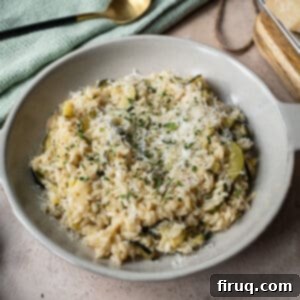
Zucchini Risotto
Vincent DelGiudiceEquipment
- 1 large saucepan
- 1 small pot
- 1 chef’s knife
Ingredients
- 2 medium zucchini, sliced and halved
- 1 cup arborio rice
- ½ cup white wine (Sauvignon Blanc or Pinot Grigio recommended)
- 3 cups chicken broth (or vegetable broth for vegetarian)
- 1 cup water
- 2 shallots, sliced (finely minced)
- 2 tablespoon extra virgin olive oil
- 1 cup Parmigiano-Reggiano, freshly grated
- 2 tablespoon fresh parsley, chopped (for garnish)
- ½ teaspoon salt (plus more to taste)
- ½ tsp black pepper (freshly ground, plus more to taste)
Instructions
- Slice the zucchini in half lengthwise, then slice into uniform ⅛ inch pieces. In a small pot, combine the chicken broth and water and warm it over medium-low heat. Keep it warm throughout the cooking process.
- Heat a large, heavy-bottomed saucepan over medium-low heat. Add the olive oil. Stir in the finely minced shallots and sauté for 2 minutes until translucent and fragrant.
- Add the sliced zucchini to the pan. Sauté for about 6-8 minutes, stirring gently and often, until the zucchini softens and is lightly golden. Season with half of the salt and pepper.
- Once the zucchini is tender, add the Arborio rice to the pan. Stir to combine, ensuring each grain is coated in oil. Toast the rice on the pan for about 3 minutes, until the edges are translucent and a small white dot is visible in the center of each grain.
- Pour in the white wine and increase the heat slightly. Bring to a simmer, stirring constantly, until the wine is almost completely absorbed by the rice.
- Begin adding the warm broth mixture, one ladleful (about 1 cup) at a time, to the rice. Stir well after each addition and wait for the liquid to be almost entirely absorbed before adding the next ladleful. Continue this process for about 18-20 minutes, stirring often to prevent sticking and encourage starch release.
- Taste the rice to check for doneness. It should be al dente – soft but with a slight bite, not crunchy. If it still has a crunch, add another ladleful of liquid and continue cooking until al dente. There should still be some liquid in the pan, giving the risotto a loose, creamy, “over-easy egg” consistency (all’onda) when you remove it from the heat. If it’s too thick, stir in a little more hot broth. Remove the pan from the heat.
- Stir in the grated Parmigiano-Reggiano, the remaining salt, pepper, and fresh chopped parsley. Toss well or stir vigorously to combine. The risotto should flow gently. Serve immediately on warm plates to maintain its perfect texture and temperature.
Notes
- The zucchini is delicate. To maintain some of its shape and texture, stir gently during cooking.
- When toasting the rice, look for a small white dot in the center of each grain, indicating it’s ready for the wine.
- A finished risotto should have a loose and creamy consistency (all’onda), not be overly sticky. There should be some liquid remaining when removed from heat.
- Serve risotto on a warm plate immediately to preserve its ideal texture and temperature.
